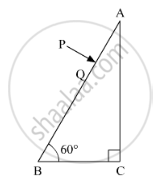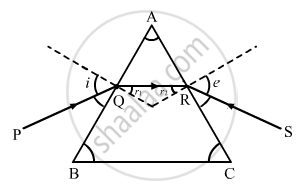Advertisements
Advertisements
प्रश्न
For any prism, prove that :
'n' or `mu = sin((A + delta_m)/2)/sin(A/2)`
where the terms have their usual meaning
उत्तर
In the figure, a ray of light PQ is incident at an angle i on the face AB of prism ABC. This ray is
refracted along QR at an angle r. This reflected ray is incident on the face AC at an angle r ' and
emerges along RS at an angle i '.
In ΔQDR
`delta = (1 - r )+ (i' + r')`
`= (i + i') - (r + r')` ....(i)

In Quad. AQER, A + E = 180° ...(ii)
In ΔQER r + r' + E = 180° ...(iii)
r + r' = A [From eq ii and iii]
Putting value r + r' inequation (i)
`delta = i + i' - A`
In the position of minimum deviation condition
`i = i', r = r', delta = delta_m`
So r + r' = A
2r = A
or `r = A/2`
`delta_m = 2i - A`
`i = (A + delta_m)/2`
Putting value of i and r from (v), (vi), in Snell’s law,
`n = sini/sin r`
`m = (sin ((A+delta_m)/2))/(sin (A/2))`
APPEARS IN
संबंधित प्रश्न
Plot a graph to show the variation of the angle of deviation as a function of the angle of incidence for light passing through a prism. Derive an expression for the refractive index of the prism in terms of angle of minimum deviation and angle of the prism.
A ray PQ incident normally on the refracting face BA is refracted in the prism BAC made of material of refractive index 1.5. Complete the path of ray through the prism. From which face will the ray emerge? Justify your answer.

A ray of light passes through an equilateral glass prism such that the angle of incidence is equal to the angle of emergence and each of these angles is equal to 3/4 of angle of prism. Find the angle of deviation.
What is the cause of dispersion of light
Figure shows a ray of light passing through a prism. If the refracted ray QR is parallel to the base BC, show that (i) r1 = r2 = A/2 and (ii) angle of minimum deviation, Dm = 2i − A.

Can the dispersive power \[\omega = \frac{\mu_u - \mu_r}{\mu - 1}\] be negative? What is the sign of ω if a hollow prism is immersed into water?
A thin prism of crown glass (μr = 1.515, μv = 1.525) and a thin prism of flint glass (μr = 1.612, μv = 1.632) are placed in contact with each other. Their refracting angles are 5.0° each and are similarly directed. Calculate the angular dispersion produced by the combination.
The refractive index of a material M1 changes by 0.014 and that of another material M2 changes by 0.024 as the colour of the light is changed from red to violet. Two thin prisms, one made of M1(A = 5.3°) and the other made of M2(A = 3.7°) are combined with their refracting angles oppositely directed. (a) Find the angular dispersion produced by the combination. (b) The prisms are now combined with their refracting angles similarly directed. Find the angular dispersion produced by the combination.
What is meant by the dispersive power of transparent material?
An equilateral glass prism has a refractive index 1.6 in the air. Calculate the angle of minimum deviation of the prism, when kept in a medium of refractive index `4sqrt(2)"/"5.`
